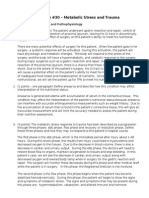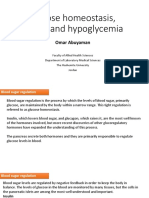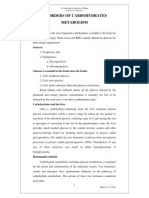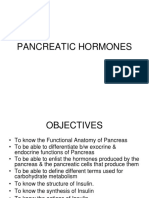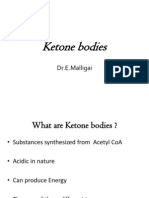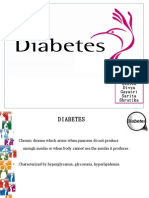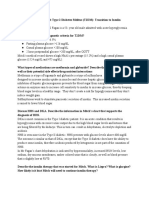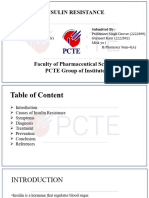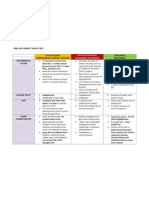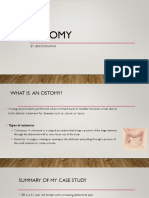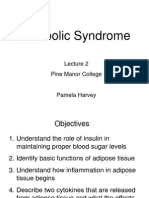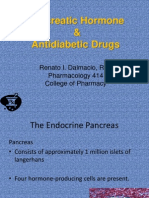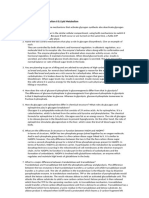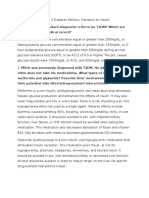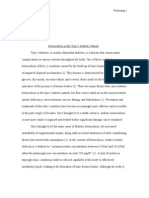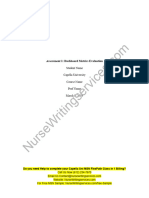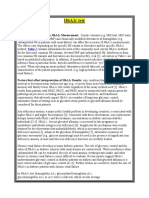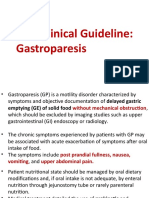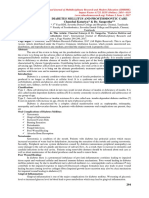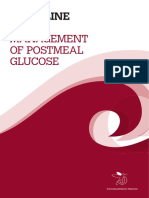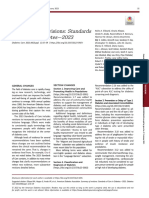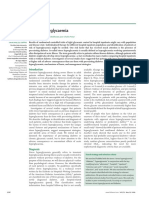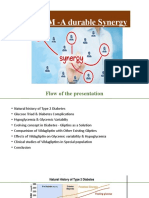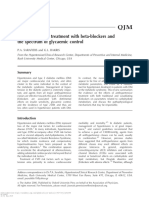Professional Documents
Culture Documents
Diabetes
Diabetes
Uploaded by
LyOriginal Description:
Copyright
Available Formats
Share this document
Did you find this document useful?
Is this content inappropriate?
Report this DocumentCopyright:
Available Formats
Diabetes
Diabetes
Uploaded by
LyCopyright:
Available Formats
Diabetes
Diabetes Mellitus: Systemic Overview
· WHO definition – diabetes mellitus (DM) is a metabolic disorder of multiple aetiology characterised by chronic
hyperglycaemia with disturbances of carbohydrates, fat, and protein metabolism resulting from defects in insulin
secretion, action, or both.
· Diabetes mellitus leads to:
o Hyperglycaemia
o Excess urine and thirst
o Blurred vision
o Unexplained weight loss
o Lethargy
· Diabetes mellitus results in:
o Long term damage or failure of organs specifically, the eyes, kidneys, nerves, heart, and blood vessels.
· Types of diabetes mellitus:
o Type 1
Insulin-dependent
Results from diminished production of insulin
Juvenile-onset
o Type 2
Non-insulin dependent
Results from impaired production and action of insulin.
Adult-onset
o Gestational diabetes
Onset during pregnancy
Impaired glucose tolerance
o Genetic syndrome affected pancreas
o Endocrinopathies
o Pancreatic disease or cancer
Diabetes Mellitus: Systemic Epidemiology
· Affects 422 million individuals worldwide and this number is expected to double in the next 20 years
· Type 1 DM:
o ~10% of cases
· Type 2 DM:
o ~85 – 90% of cases
o Affecting 20% of the population over 65 years
o 10%+ of the health budget in many countries is used for Type 2 DM care
Diabetes Mellitus: Normal Glucose Metabolism
· Basal or fasting glucose metabolism
o Under basal conditions
~50% of glucose is used by the brain
Insulin independent
~25% of glucose is used by the liver or gastrointestinal tissues
Insulin independent
~25% of glucose is used by the muscle
Insulin dependent
o Hepatic glucose production: the liver produces glucose from glycogen to meet the needs of the brain and
other tissues. The liver has glycogen stores (stores of glucose).
o Other sources of glucose production:
Adipose breaks down fat stores to release free fatty acids
The muscle can use its own glycogen or free fatty acids
· Islets of Langerhans
o Small endocrine glands located in the pancreas
o Four types:
α -cells synthesise glucagon
β -cells synthesise insulin
· Following glucose ingestion there is an/a:
o Increase in plasma glucose levels
o Stimulation of insulin release
o Inhibition of glucagon release
· Insulin acts on various tissues:
o Muscle – to increase glucose uptake and promote glycogen and protein synthesis from glucose
o Adipose (fat) – to increase glucose uptake, promote lipid synthesis from glucose, and decrease lipid
breakdown
o Liver – to decrease glucose production, and promote glycogen and lipid synthesis from glucose
· Process:
o Insulin binds to specific receptors on the cell surface.
o Secondary messengers initiate a signal cascade to stimulate glucose uptake.
o A drop in blood glucose level leads to decrease release of insulin.
Diabetes Mellitus: Type 1
· Aetiology:
o Autoimmune destruction of β -cells that produce insulin leading to insulin deficiency. Insulin deficiency
causes hyperglycaemia as:
Muscle and adipose tissue cannot respond to glucose ingestion
Liver and adipose tissue continue to produce glucose despite ingestion.
o Occurring in genetically predisposed individuals
Major locus: human leukocyte antigen (HLA) contributes to genetic susceptibility to type 1 DM. Genes
in HLA are reported to account for a 50 – 60% genetic risk.
HLA genes affects HLA protein binding to antigenic peptides and antigen presentation to T cells
· Pathophysiology:
o Environmental factors trigger an autoimmune response
Viral, other infections, and/or altered intestinal microbiome
Timing of exposure is critical based on the early onset nature of type 1 DM
o Autoimmune response:
Activation of T cells reactive to islet cell antigens
T cells destroy islet cells resulting in insulin deficiency
o New theories/ ideas:
Events leading to Type 1 DM occur in utero
β cell loss is not linear (continuum) and β cells still remain in longstanding disease.
· Work-up:
o Blood glucose test – provides a snapshot of hyperglycemia.
Random: 11.1 mmol/L or higher
Fasting: 7.0 mmol/L or higher
o Glycosylated haemoglobin test (HBA1C) – reflects long term blood glucose control.
% of blood sugar attached to haemoglobin
HbA (haemoglobin) stay glycosylated (1C) until they degrade (approx. 3 months)
Indicates blood glucose control over a long period of time
Only confirmed indicator to estimate risk of developing diabetic complications
HbA1C of 7% or higher on two separate tests
o Additional tests:
Blood test to check for antibodies
Urine test for ketones
· Management:
o Traditional: finger prick tests + insulin injections several times a day
o New technologies: continuous glucose monitors which take readings every 5 minutes.
o Insulin pump:
Delivers insulin via catheter under the skin continuously over 24 hours
Uses less insulin and mimics normal insulin production
During meals, the pump can be programmed to provide extra insulin
The downfall is that it is costly and can lead to associated weight gain and infection at the cannula site.
o Insulin analogues: genetically altered to be more rapid or more uniforming acting.
o Combinations:
Ultra-long-acting insulin + rapid acting insulin analogue e.g., Ryzodeg 70/10
Administered once daily with main carbohydrate meal
Diabetes Mellitus: Type 2
· Aetiology: involves insulin resistance which causes insulin overproduction and overtime this leads to β -cell
dysfunction; defects in the insulin pathway.
o There are many risk factors (genetic and environmental) but the exact pathogenesis remains unclear.
o Insulin resistance seems to be related to defects in insulin receptors on cells or other proteins in the insulin
signalling pathway.
o Even though the absolute levels of insulin may be high in type 2 DM individuals, they are low relative to the
individual’s needs.
· Pathophysiology:
o Defects in insulin receptor or post-receptor elements leading to insulin resistance. Defects include:
Decreased number of insulin receptors
Decreased tyrosine kinase activity (secondary messenger)
Decreased glucose transporter activity
Decreased glycogen production
o Insulin resistance leads to:
Poor uptake of glucose by muscle and adipose
Poor suppression of hepatic glucose production
Impaired lipid uptake by adipose tissue
o β cells increase insulin production to compensate for poor glucose uptake. Eventually β cells deteriorate
leading to insulin deficiency. Deterioration occurs because of exhaustion (burnout), glucotoxicity, and/or
amyloid deposition.
· Risk factors:
o Overweight/ obesity
o Physically inactive
o Hypertension
o Low high-density lipoprotein (HDL) or high trigylcerides
o Age, 45 or older
o Family history
o History of gestational diabetes
o Ethnicity – African American, Hispanic, Pacific Islander
· Diagnosis: blood glucose tests, HbA1C
· Treatment:
o Lifestyle modifications – diet and exercise
o Oral hypoglycaemic medication
Biguanides (metformin) e.g., Diabex, Diaformin
1st line
Reduces hepatic glucose production
Increases peripheral use of glucose
Sulfonylureas – increases insulin secretion e.g., gliclazide (Diamicron)
SGLT2 – inhibits SGLT2, reducing glucose reabsorption by the kidney e.g., empagliflozin (Jardiance,
Jardiamet)
Fibrates – unknown lipid lowering effect.
o Non-insulin injectables
Glucagon-like peptide (GLP-1) analogues
Signals the hypothalamus to decrease food intake (feeling full)
Increases glucose-dependent insulin secretion from pancrease
E.g., Bydureon and Byetta (exenatide) – derived from the saliva of a lizard (gila-moster),
Dulaglutide – consists of GLP-1 (7 – 37) covalently linked to an Fc fragment of human IgG4,
Victosa (liraglutide) – derivative of a human incretin (metabolic hormone).
o Insulin therapy
Insulin-sensitising agents e.g., thiazolidinediones, biguanides
Insulin stimulators e.g., sulfonylureas, GLP-I analogues, DPP 4 inhibitors
Insulin-dependent hypoglycaemia agents e.g., SGLT2
Note, a patient on insulin does not necessarily have type 1 DM. Insulin may be added into the tx for
a type 2 DM to improve their overall glycaemic control.
o Combination therapy
o Blood pressure management
o Blood lipid management
· Nearly 50% of Australians with DM are not at the target HbA1c. Reasons include:
o Therapy not initiated at the correct time or being optimised early.
o Reluctance to initiate to injectable therapy.
o Reluctance to intensify to insulin treatment.
o Not rechecking HbA1c – should be performed every 3 to 6 months
o Suboptimal patient adherence e.g., running out of medication or dropping specific medications
o Healthcare delivery systems.
Diabetes Mellitus: Gestational
· Aetiology: onset during pregnancy; placental hormones block insulin during pregnancy. If insulin resistance
already exists, the body cannot cope with the extra demand for insulin, leading to hyperglycaemia.
o Risk factors: older age, family history of DM, high BMI, certain ethnicities
o Occurs in 14 – 16% of pregnant women
o Patients are not at risk of developing DM-related retinopathy
· Management: diet, physical activity, monitoring blood glucose levels and insulin.
o Most resolved following birth however, the risk of the mother and baby developing type 2 DM in later life is
increased.
Diabetes Mellitus: Complications
· Complications include:
o Cardiovascular/ coronary artery disease – macrovascular
o Peripheral arterial disease – macrovascular
o Neuropathy – microvascular
o Nephropathy (kidney) – microvascular
o Retinopathy – microvascular
o Foot damage
o Skin conditions
o Hearing impairment
o Alzheimer’s disease
o Stroke – macrovascular
o Depression
· Pathophysiology of diabetes complications:
o Longstanding hyperglycaemia activates/ alters many cellular pathways
Increased reactive oxygen species (ROS) formation from activation of mitochondrial electron-transport
chain
Activation of the polyol pathway
Activation of the hexosamine pathway
Activation of protein kinase C
Increases production of advanced glycation end products (AGEs)
Longstanding hyperglycaemia leads to glycosylation of proteins
Over time glycosylated proteins become advanced glycation end products (AGEs)
AGEs can lead to oxidative stress, changes in haemodynamic, and initiation of the inflammation
cascade
o Pathways defects lead to development of microvascular and macrovascular complications via
Endothelial dysfunction and altered haemodynamic and perfusion properties
Tissue ischaemia and oxidative stress
Inflammation and immune responses
o AGEs and retinopathy – diabetic related damage to the blood vessels of the retinal.
Role of AGEs:
Increase vessel permeability causing leakage and breakdown of the blood-retinal barrier
Increase vascular stiffness
Upregulate VEGF which stimulates angiogenesis and neovascularisation
o AGEs and nephropathy – diabetic related damage to the kidney which leads to haemodynamic changes
(hyperfiltration and hyperperfusion), proteinuria, poor glomerular filtration rate and eventually renal failure.
Role of AGEs:
Reduce glomerular filtration capacity by altering normal structure of ECM proteins and basement
membrane permeability
Stimulate growth factors and cytokines which induce hyperfiltration and hyperperfusion
o AGEs and neuropathy – diabetic induced nerve damage. Typically, affects peripheral tissues e.g., legs and
feet.
Role of AGEs:
Modified axon proteins leading to nerve fibre atrophy
Increased micro vessel permeability and reduced nerve blood flow, inducing hypoxia.
Diabetes Mellitus: Ocular
Diabetes & Vision Loss
Major causes of vision loss in diabetes
1. Diabetic Macula Oedema
· Untreated diabetic macula oedema (DME) is the major cause of moderate vision loss in people with diabetes
· Abnormal accumulation of excess fluid within the extracellular spaces of the neurosensory retina due to
breakdown of the blood-retinal barrier
2. Vitreous or Preretinal Haemorrhage
3. Tractional Retinal Detachment (in proliferative DR)
· New vessels can produce fibre scaffolding which may retract and pull the retina off
4. Diabetes Macula Ischaemia (DMI)
· Visual acuity loss may occur in cases of moderate to severe DMI
· DMI is difficult to detect with fundoscopy. Historically, fluorescein angiography was used in cases of
unexplained VA loss and to diagnose DMI.
· OCT angiography is a new method which enables optometrist to quickly and non-invasively assess for
diabetic macula ischaemia.
Enlargement of the foveal
avascular zone (FAZ)
Paramacular capillary
non-perfusion
Diabetes Retinopathy Snapshot
· DR is the leading cause of preventable vision loss in working age adults
· DR is the most frequent cause of new blindness in individuals aged 20 – 74 years in developed countries
· Global prevalence of diabetic retinopathy is ~34.6%
o 1 in 10 of these individuals had vision threatening diabetic retinopathy
· Blue Mountains Eye Study (1992-1994)
o Of the participants >49 years with diabetes:
32.4% had diabetic retinopathy
4.3% had vision threatening macular oedema
1.6% had proliferative diabetic retinopathy
· National Indigenous Eye Health Survey (2009)
o 36% of people with diabetes had diabetic retinopathy
· National Eye Health Survey (2016)
o Only 78% of non-Indigenous and 53% of Indigenous people had received the NHMRC recommended
biannual diabetes eye check
· Diabetic retinopathy is typically asymptomatic when most treatable
o 98% of severe vision loss is preventable with early detection and treatment
Broad Rule of Thumb
1/3 of patients with diabetes have diabetic retinopathy
1/3 of those patients have vision threatening diabetic retinopathy
Other Ocular Conditions Associated with Diabetes
· Refraction and accommodation shifts
o Refractive error changes
Osmotic changes to the cortex – the lens thickens
Transient hyperopic change in the patient receiving improved control after hyperglycaemia
o Reduced amplitude of accommodation found in young individuals with type 1 DM
· Colour vision defects
o Blue-yellow or red-green defects may precede diabetic retinopathy development
o The level of 100 Hue change correlates with the level of diabetic retinopathy
· Pupil miosis and sluggish reactions
o Sluggish reactions, miotic, and weaker reaction to mydriatics
o Consider dilating with tropicamide and phenylephrine if indicated
· Neovascular Glaucoma
o Fibrovascular network of vessels grows over the angle structures leading to IOP increase and secondary
glaucoma
o Iris rubeosis is usually first observed at the pupil margin. However, neovascular vessels may infiltrate the
angle without any vessels visible on slit lamp examination.
o Gonioscopy is indicated when the IOP is elevated or asymmetrical.
· Primary Open Angle Glaucoma
o Studies provide conflicting evidence on whether diabetes mellitus is a risk factor for POAG
Systematic review (Zhao D., Ophthalmology 2015) showed that diabetes, diabetes duration, and fasting
glucose levels were associated with a significantly increase of glaucoma and that DM is associated with
increased IOP
o Glaucomatous optic neuropathy may be influenced by:
Lower retrobulbar flow in the central retinal artery
Higher retinal microcirculation flow
Concomitant systemic hypertension affecting vascular perfusion of the optic nerve head
Formation of AGEs in the trabecular meshwork and lamina cribrosa
· Cataract
o Hyperglycaemia and diabetes duration are risk factors
o Tends to develop earlier and progress more rapidly
o Increased prevalence of posterior subcapsular cataracts and cortical cataracts (+ nuclear sclerosis in type 2
DM)
o Reversible lens opacities and snowflake opacities – may go away with appropriate control
o Deposition of advanced glycosylation end-products is a postulated mechanism
· Cornea
o Impaired corneal wound healing
Higher risk of SPK, RCE/ epithelial basement membrane disorders, persistent epithelial defects,
endothelial dysfunction, and corneal nerve impairment
o Reduced corneal sensitivity due to neuropathy of the ophthalmic division of the trigeminal nerve
May reduce reflex tear secretion and subjective symptomatology
Alters tear chemistry
May increase risk of neurotrophic keratitis
o Contact lens-related microbial keratitis
Avoid extended wear
· Anterior Eye
·
· Cranial nerve palsies
· Visual field defects
· Posterior vitreous detachment
· Vitreous degeneration
· Iris depigmentation
· Tear film anomalies/ lacrimal gland damage
· Higher IOP
· Conjunctival microaneurysms
· Accommodative dysfunction
· NAAION
· Papillopathy
You might also like
- STEP 2 CK New Free 120 (Q)Document59 pagesSTEP 2 CK New Free 120 (Q)M. Baidar Saeed100% (1)
- Biochemistry CasesTeenage Weakling 2015Document5 pagesBiochemistry CasesTeenage Weakling 2015Neel KotrappaNo ratings yet
- Forxiga Slide RTD 2017 - 2Document64 pagesForxiga Slide RTD 2017 - 2Budi WirawanNo ratings yet
- NBHS1112 Biochemistry/ Biokimia May Semester 2022Document16 pagesNBHS1112 Biochemistry/ Biokimia May Semester 2022amu tha100% (1)
- Case Study 18Document5 pagesCase Study 18Natalie Meltzer0% (2)
- Case Study 30Document6 pagesCase Study 30api-276551783No ratings yet
- Diabetes Conversation Maps: Journey To Better Diabetes EducationDocument1 pageDiabetes Conversation Maps: Journey To Better Diabetes EducationCenter for Managing Chronic DiseaseNo ratings yet
- Tirzepatide Significantly Reduced A1C and Body Weight in People With Type 2 Diabetes in Two Phase 3 Trials From Lilly's SURPASS ProgramDocument4 pagesTirzepatide Significantly Reduced A1C and Body Weight in People With Type 2 Diabetes in Two Phase 3 Trials From Lilly's SURPASS ProgramJOSÉ CARLOS ÁLVAREZ PAYARESNo ratings yet
- Glucose, Part1Document33 pagesGlucose, Part1SarahNo ratings yet
- Diabetes Mellitus and Cho Dis.Document15 pagesDiabetes Mellitus and Cho Dis.abdo000No ratings yet
- INSULINDocument54 pagesINSULINBalai Pom PaluNo ratings yet
- DyslipidemiaDocument63 pagesDyslipidemiaJuhliad LebenuNo ratings yet
- The Role of Dietary Factors and Food Habits in The Development of Childhood ObesityDocument23 pagesThe Role of Dietary Factors and Food Habits in The Development of Childhood ObesitydnllkzaNo ratings yet
- 05.17 Metabolic Effects of Insulin and Glucagon - W2016-2Document28 pages05.17 Metabolic Effects of Insulin and Glucagon - W2016-2Rima Gi100% (1)
- Carbohydrate, Lipid, Protein MetabolismDocument3 pagesCarbohydrate, Lipid, Protein Metabolismtritone.paradoxNo ratings yet
- Cholesterol - Synthesis, Metabolism, Regulation PDFDocument10 pagesCholesterol - Synthesis, Metabolism, Regulation PDFAdreiTheTripleA100% (1)
- Pharmacology of Antidiabetic Drugs For Second Year Medicine StudentsDocument54 pagesPharmacology of Antidiabetic Drugs For Second Year Medicine StudentsAmanuel MaruNo ratings yet
- Diabetic KetoacidosisDocument22 pagesDiabetic KetoacidosispoktaviantiNo ratings yet
- Insulin and Oral HypoglycemicsDocument38 pagesInsulin and Oral HypoglycemicsEdwin GithogeNo ratings yet
- Ketone Bodies 2012Document15 pagesKetone Bodies 2012Adhya MurugesanNo ratings yet
- Insulin ResistanceDocument48 pagesInsulin ResistanceLavina JainNo ratings yet
- Atherosclerosis-Dyslipidaemia and Diabetes SlidesDocument83 pagesAtherosclerosis-Dyslipidaemia and Diabetes SlidesECG17No ratings yet
- Alzheimer's Disease: Causes, Effects, and TreatmentsDocument21 pagesAlzheimer's Disease: Causes, Effects, and TreatmentsJesshica Navarro AlejandrinoNo ratings yet
- Case Studies 19,20,21Document5 pagesCase Studies 19,20,21hailey guzzoNo ratings yet
- Terapi Insulin-1Document46 pagesTerapi Insulin-1Yanti MoonNo ratings yet
- Ablilasha Ashish Divya Gayatri Sarita Shrutika:: Presented byDocument52 pagesAblilasha Ashish Divya Gayatri Sarita Shrutika:: Presented bysashk_lucky21100% (1)
- Diabetes KetoacidosisDocument23 pagesDiabetes KetoacidosisSalman MajidNo ratings yet
- Type2dm PDFDocument3 pagesType2dm PDFapi-303065684No ratings yet
- Diabetic Ketoacidosis:: Evidence Based ReviewDocument4 pagesDiabetic Ketoacidosis:: Evidence Based ReviewgracedumaNo ratings yet
- Metabolic Syndrome Is Related Cardio-Cerebro Vascular DiseaseDocument40 pagesMetabolic Syndrome Is Related Cardio-Cerebro Vascular DiseaseSatya FitriansyahNo ratings yet
- Biochemical Changes in PregnancyDocument6 pagesBiochemical Changes in PregnancyDr.Aaisha Mohammed Al BalushiNo ratings yet
- Diabetic KetoacidosisDocument13 pagesDiabetic KetoacidosisMabelle Blancada ConsultaNo ratings yet
- Fed State of MetabolismDocument40 pagesFed State of MetabolismBHARANIDHARAN M.VNo ratings yet
- Insulin ResistanceDocument12 pagesInsulin ResistancePrabhmeet Grover100% (1)
- Ketogenic Diet in The Management of Diabetes: June 2017Document8 pagesKetogenic Diet in The Management of Diabetes: June 2017Indra Setya PermanaNo ratings yet
- Oral Antidiabetic AgentsDocument4 pagesOral Antidiabetic AgentsFendi Ali100% (1)
- Nut116bl Minics 2 Peds Nafld 2017Document5 pagesNut116bl Minics 2 Peds Nafld 2017api-347153077No ratings yet
- Final MNT Ostomy 1Document11 pagesFinal MNT Ostomy 1api-366154535100% (1)
- Metabolic Syndrome Lecture 2Document34 pagesMetabolic Syndrome Lecture 2Muhammad Riandy Lukman Tanjung100% (1)
- Pathology and Medical Therapy of Benign Prostatic HyperplasiaDocument5 pagesPathology and Medical Therapy of Benign Prostatic HyperplasiaRose Deasy100% (1)
- Diabetic KetoacidosisDocument27 pagesDiabetic Ketoacidosisjun sianNo ratings yet
- Pancreatic Hormone & Antidiabetic Drugs: Renato I. Dalmacio, RPH Pharmacology 414 College of PharmacyDocument69 pagesPancreatic Hormone & Antidiabetic Drugs: Renato I. Dalmacio, RPH Pharmacology 414 College of PharmacyRalf EmoteroNo ratings yet
- Diet During Adulthood UbDocument34 pagesDiet During Adulthood UbBeatrice Chen0% (1)
- Diabetic Ketoacidosis in PaediatricDocument11 pagesDiabetic Ketoacidosis in PaediatricSana Anam JahanNo ratings yet
- Fellowship in DiabetesDocument2 pagesFellowship in DiabetesBenjamin NelsonNo ratings yet
- Sustaine 10Document10 pagesSustaine 10Ivan Dario Hernandez ErazoNo ratings yet
- HW - Carbohydrate Metabolism II & Lipid MetabolismDocument2 pagesHW - Carbohydrate Metabolism II & Lipid MetabolismyanNo ratings yet
- Case Study 3Document10 pagesCase Study 3api-271185611No ratings yet
- Endocrine Emergencies in The ICUDocument47 pagesEndocrine Emergencies in The ICUchadchimaNo ratings yet
- BIOS LIFE - Diabetes in Control Study #2 by Steven Freed and David JoffeDocument1 pageBIOS LIFE - Diabetes in Control Study #2 by Steven Freed and David JoffeHisWellnessNo ratings yet
- Medicine and Nutrition Case StudyDocument5 pagesMedicine and Nutrition Case Studyapi-384113918No ratings yet
- Oral Antidiabetic Drugs 2017BDocument39 pagesOral Antidiabetic Drugs 2017BDineish MurugaiahNo ratings yet
- Anaerobic Metabolism of Carbohydrates in RBC - Lectue XXIDocument4 pagesAnaerobic Metabolism of Carbohydrates in RBC - Lectue XXISaulNo ratings yet
- Type 2 Diabetes Mellitus Case StudyDocument9 pagesType 2 Diabetes Mellitus Case StudyMike CoolNo ratings yet
- Von Gierke DiseaseDocument14 pagesVon Gierke Diseaseapi-590506208No ratings yet
- Approach To Managing Increased Risk For Cardiovascular Disease in Patients With Severe Mental Illness - UpToDateDocument18 pagesApproach To Managing Increased Risk For Cardiovascular Disease in Patients With Severe Mental Illness - UpToDateBillis ParaschouNo ratings yet
- Diabetic KetoacidosisDocument5 pagesDiabetic Ketoacidosislpickering33No ratings yet
- Physiology and Causes of DiabatesDocument7 pagesPhysiology and Causes of DiabatesasaadsarfrazNo ratings yet
- Drugs For Constipation and DiarrheaDocument40 pagesDrugs For Constipation and Diarrheagirgray100% (1)
- Obesity PPT (Mahla)Document97 pagesObesity PPT (Mahla)kamlesh pariharNo ratings yet
- Renal Exchange List KardexDocument2 pagesRenal Exchange List KardexKathlene GamitNo ratings yet
- Mediterranean Diet Cookbook for Beginners: Unlock the Health Benefits of the Mediterranean Diet with Easy and Delicious Recipes for Everyday Eating!From EverandMediterranean Diet Cookbook for Beginners: Unlock the Health Benefits of the Mediterranean Diet with Easy and Delicious Recipes for Everyday Eating!No ratings yet
- Gastrointestinal Diseases and Disorders Sourcebook, Fifth EditionFrom EverandGastrointestinal Diseases and Disorders Sourcebook, Fifth EditionNo ratings yet
- Diabetic RetinopathyDocument36 pagesDiabetic RetinopathyRaúl Plasencia SaliniNo ratings yet
- NHS FPX 6004 Assessment 1 Dashboard Metrics EvaluationDocument7 pagesNHS FPX 6004 Assessment 1 Dashboard Metrics Evaluationlilykevin075No ratings yet
- DiaTribe - Research and Product News For People With Diabetes - Issue #7Document20 pagesDiaTribe - Research and Product News For People With Diabetes - Issue #7diatribe100% (2)
- Definition of DiabetesDocument6 pagesDefinition of DiabetesSuyi PhoebeNo ratings yet
- Food and Exercise LogDocument24 pagesFood and Exercise LogmhetfieldNo ratings yet
- Hba1c TestDocument3 pagesHba1c TestRITESH SINGHNo ratings yet
- Diabetes Mellitus: DR Hiew Fu LiongDocument30 pagesDiabetes Mellitus: DR Hiew Fu LiongamminsaffriNo ratings yet
- Gastroparesis. ACGDocument45 pagesGastroparesis. ACGNaser EsmailiNo ratings yet
- Diabetes Mellitus and Prosthodontic Care Chanchal Katariya & Dr. SangeethaDocument3 pagesDiabetes Mellitus and Prosthodontic Care Chanchal Katariya & Dr. SangeethaArushi AgarwalNo ratings yet
- Guideline PMG IDF 2007Document32 pagesGuideline PMG IDF 2007kesuma wardaniNo ratings yet
- epid15,+07.+Marisa+Gita+Putri Inggris 256+sd+264Document9 pagesepid15,+07.+Marisa+Gita+Putri Inggris 256+sd+264Selmitha SariNo ratings yet
- Insulin Therapy: by Dr. Adithya PolavarapuDocument18 pagesInsulin Therapy: by Dr. Adithya Polavarapuadithya polavarapuNo ratings yet
- DC 23 SrevDocument5 pagesDC 23 SrevItzel TextaNo ratings yet
- Diabetes in Pregnancy Western Cape GuidelinesDocument41 pagesDiabetes in Pregnancy Western Cape GuidelinespaingmyintNo ratings yet
- Decision Algorithm For Prescribing SGLT2 Inhibitors and GLP-1 Receptor AgonistsDocument11 pagesDecision Algorithm For Prescribing SGLT2 Inhibitors and GLP-1 Receptor AgonistsNati BocciaNo ratings yet
- Chapter 91 - Diabetes MellitusDocument75 pagesChapter 91 - Diabetes MellitusPhúc NguyễnNo ratings yet
- Diabetic Peripheral Neuropathy: Epidemiology, Diagnosis, and PharmacotherapyDocument22 pagesDiabetic Peripheral Neuropathy: Epidemiology, Diagnosis, and PharmacotherapykaremiaNo ratings yet
- Adult-Onset Type 1 Diabetes - Current Understanding and Challenges Nov 2021Document8 pagesAdult-Onset Type 1 Diabetes - Current Understanding and Challenges Nov 2021Katuya KatuyaNo ratings yet
- Management of Diabetes Mellitus in Surgical PatientsDocument12 pagesManagement of Diabetes Mellitus in Surgical PatientsAnggoro Bayu Agung DjangkaruNo ratings yet
- Team Aproach With Diabetes PatientsDocument5 pagesTeam Aproach With Diabetes PatientsLuis Vazquez MoralesNo ratings yet
- Management of Type 2 Diabetes During Ramadan: The Role of Gliclazide MRDocument25 pagesManagement of Type 2 Diabetes During Ramadan: The Role of Gliclazide MRMuhammad SugiartoNo ratings yet
- Stress Hyperglycaemia: SeminarDocument10 pagesStress Hyperglycaemia: SeminarPauPatiñoNo ratings yet
- Vildagliptin: The Evidence For Its Place in The Treatment of Type 2 Diabetes MellitusDocument18 pagesVildagliptin: The Evidence For Its Place in The Treatment of Type 2 Diabetes Mellitusp k agarwalNo ratings yet
- Vicemic (Vildagliptin)Document35 pagesVicemic (Vildagliptin)Nimesh ModiNo ratings yet
- GLYBURIDEDocument3 pagesGLYBURIDEJohn Carlo SamsonNo ratings yet
- Beta BlockersDocument6 pagesBeta BlockersGopinath AgnihotramNo ratings yet
- Textbook Handbook of Diabetes Technology Yves Reznik Ebook All Chapter PDFDocument53 pagesTextbook Handbook of Diabetes Technology Yves Reznik Ebook All Chapter PDFjames.petty876100% (13)





